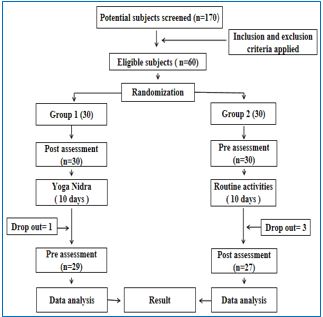Effect of Yoga Nidra (Psychic Sleep) in patients with Alcoholic Hypertensives - A Randomized Controlled Trial
DOI:
https://doi.org/10.21760/jaims.8.1.3Keywords:
Alcohol Dependent Individuals; Heart Rate variability, Hypertension, Yoga NidraAbstract
Background: Primary Hypertension in alcoholic individuals is one of the major health issues of the society. Yoga is found to have a wonderful tool to treat primary hypertension in alcoholic individuals. Yoga Nidra, is a cost effective tool to manage these symptoms. Objectives: The objectives of the study are to assess whether Yoga Nidra is having effect on blood pressure, heart rate variability & respiratory rate in primary hypertensive alcohol dependent individuals. Materials and Methods: A total of sixty primary hypertensive alcoholic dependent individuals have been recruited after they meet the inclusion and exclusion criteria and the screening of the subjects by using Alcohol Use Disorders Identification Test (AUDIT) questionnaire and into two Groups, Subjects in the group one practiced Yoga Nidra for a period of 10 days and group two carried on its routine activities. Both the groups were assessed for blood pressure, heart rate variability & respiratory rate at day one and day ten. Results: In the present study comparison between the group there was a significant results seen in the HR, RR, SBP with P value < 0.0001, LF/HF ratio with P value < 0.0500, DBP with P value< 0.0257 respectively. Conclusion: Ten days of Yoga Nidra practice has shown to bring a positive influence in primary hypertensive alcoholic dependent individuals in improving HR, RR, Mean RR, RMSSD, NN50, PNN50, VLF, LF, HF, LF/HF ratio, SBP & DBP.
Downloads
References
Carretero OA, Oparil S. Essential hypertension. Part I: definition and etiology. Circulation. 2000 Jan 25;101(3):329–35.
Zeng C, Villar VAM, Yu P, Zhou L, Jose PA. Reactive oxygen species and dopamine receptor function in essential hypertension. Clin Exp Hypertens. 2009 Apr;31(2):156–78.
Fauci AS, editor. Harrison’s principles of internal medicine: editors, Anthony S. Fauci ... [et al.]. 17th ed. New York: McGraw-Hill Medical; 2008. 1 p.
Luma GB, Spiotta RT. Hypertension in children and adolescents. Am Fam Physician. 2006 May 1;73(9):1558–68.
Nakao M, Yano E, Nomura S, Kuboki T. Blood pressure-lowering effects of biofeedback treatment in hypertension: a meta-analysis of randomized controlled trials. Hypertens Res. 2003 Jan;26(1):37–46.
Innes KE, Bourguignon C, Taylor AG. Risk indices associated with the insulin resistance syndrome, cardiovascular disease, and possible protection with yoga: a systematic review. J Am Board Fam Pract. 2005;18(6):491–519.
Satchidananda, Patañjali. The yoga sutras of Patanjali. Yogaville, Va: Integral Yoga Publications; 1990. 263 p.
Garfinkel M, Schumacher HR. Yoga. Rheum Dis Clin North Am. 2000 Feb;26(1):125–32, x.
Saper RB, Eisenberg DM, Davis RB, Culpepper L, Phillips RS. Prevalence and patterns of adult yoga use in the United States: results of a national survey. Altern Ther Health Med. 2004;10(2):44–9.
Hoyez AC. The ‘world of yoga’: The production and reproduction of therapeutic landscapes. Social Science & Medicine. 2007 Jul;65(1):112–24.
Cowen VS, Adams TB. Physical and perceptual benefits of yoga asana practice: results of a pilot study. Journal of Bodywork and Movement Therapies. 2005 Jul;9(3):211–9.
Long L, Huntley A, Ernst E. Which complementary and alternative therapies benefit which conditions? A survey of the opinions of 223 professional organizations. Complement Ther Med. 2001 Sep;9(3):178–85.
Hoffman JW, Benson H, Arns PA, Stainbrook GL, Landsberg GL, Young JB, et al. Reduced sympathetic nervous system responsivity associated with the relaxation response. Science. 1982 Jan 8;215(4529):190–2.
Sandlund ES, Norlander T. The Effects of Tai Chi Chuan Relaxation and Exercise on Stress Responses and Well-Being: An Overview of Research. International Journal of Stress Management. 2000;7(2):139–49.
Benson H, Greenwood MM, Klemchuk H. The relaxation response: psychophysiologic aspects and clinical applications. Int J Psychiatry Med. 1975;6(1–2):87–98.
Satyānanda. Yoga nidra. 6. ed., Repr. Munger: Yoga Publ. Trust; 2005. 261 p.
Kovell LC, Ahmed HM, Misra S, Whelton SP, Prokopowicz GP, Blumenthal RS, et al. US Hypertension Management Guidelines: A Review of the Recent Past and Recommendations for the Future. JAHA. 2015 Dec;4(12):e002315.
Srivastava N, Rani K, Tiwari S, Singh U, Agrawal G. Six-month trial of Yoga Nidra in menstrual disorder patients: Effects on somatoform symptoms. Ind Psychiatry J. 2011;20(2):97.
Eastman-Mueller H, Wilson T, Jung AK, Kimura A, Tarrant J. iRest yoga-nidra on the college campus: changes in stress, depression, worry, and mindfulness. Int J Yoga Therap. 2013;(23):15–24.
Raghuraj P, Ramakrishnan AG, Nagendra HR, Telles S. Effect of two selected yogic breathing techniques of heart rate variability. Indian J Physiol Pharmacol. 1998 Oct;42(4):467–72.
Ghiya S, Lee CM. Influence of alternate nostril breathing on heart rate variability in non-practitioners of yogic breathing. Int J Yoga. 2012 Jan;5(1):66–9.
Spicuzza L, Gabutti A, Porta C, Montano N, Bernardi L. Yoga and chemoreflex response to hypoxia and hypercapnia. Lancet. 2000 Oct 28;356(9240):1495–6.
Thirthalli J, Naveen GH, Rao MG, Varambally S, Christopher R, Gangadhar BN. Cortisol and antidepressant effects of yoga. Indian J Psychiatry. 2013 Jul;55(Suppl 3):S405-408.
Francis DP, Ponikowski P, Coats AJS. Chemoreceptor-Baroreceptor Interactions in Cardiovascular Disease. In: Sleep Apnea. CRC Press; 2000.
Narkiewicz K, van de Borne PJ, Montano N, Dyken ME, Phillips BG, Somers VK. Contribution of tonic chemoreflex activation to sympathetic activity and blood pressure in patients with obstructive sleep apnea. Circulation. 1998 Mar 17;97(10):943–5.
Trzebski A, Tafil M, Zoltowski M, Przybylski J. Increased sensitivity of the arterial chemoreceptor drive in young men with mild hypertension. Cardiovasc Res. 1982 Mar;16(3):163–72.
Somers VK, Mark AL, Abboud FM. Potentiation of sympathetic nerve responses to hypoxia in borderline hypertensive subjects. Hypertension. 1988 Jun;11(6 Pt 2):608–12.
Hainsworth R. Circulatory responses from lung inflation in anesthetized dogs. Am J Physiol. 1974 Feb;226(2):247–55.
Joseph CN, Porta C, Casucci G, Casiraghi N, Maffeis M, Rossi M, et al. Slow breathing improves arterial baroreflex sensitivity and decreases blood pressure in essential hypertension. Hypertension. 2005 Oct;46(4):714–8.
Jerath R, Edry JW, Barnes VA, Jerath V. Physiology of long pranayamic breathing: neural respiratory elements may provide a mechanism that explains how slow deep breathing shifts the autonomic nervous system. Med Hypotheses. 2006;67(3):566–71.















